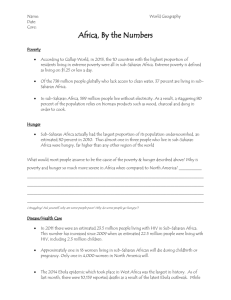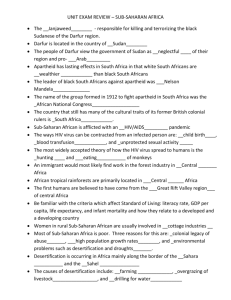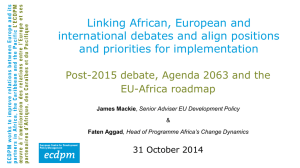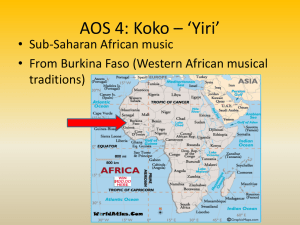The EU 's 'strategic partnership' with Africa: Model or Placebo? A
advertisement
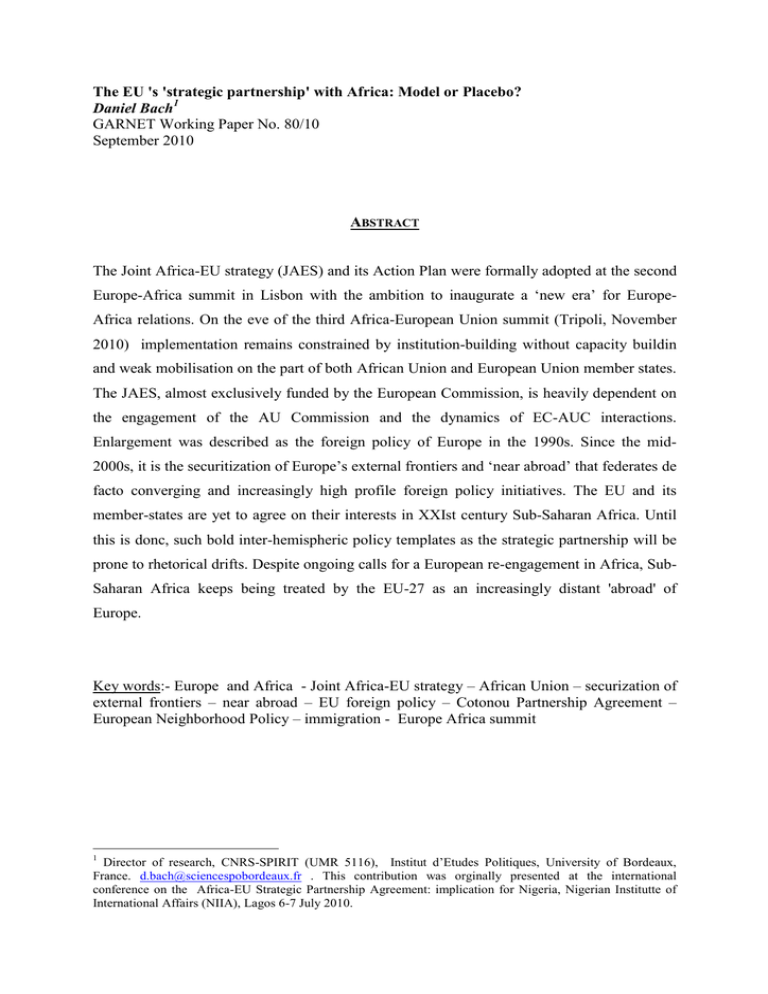
The EU 's 'strategic partnership' with Africa: Model or Placebo? Daniel Bach1 GARNET Working Paper No. 80/10 September 2010 ABSTRACT The Joint Africa-EU strategy (JAES) and its Action Plan were formally adopted at the second Europe-Africa summit in Lisbon with the ambition to inaugurate a ‘new era’ for EuropeAfrica relations. On the eve of the third Africa-European Union summit (Tripoli, November 2010) implementation remains constrained by institution-building without capacity buildin and weak mobilisation on the part of both African Union and European Union member states. The JAES, almost exclusively funded by the European Commission, is heavily dependent on the engagement of the AU Commission and the dynamics of EC-AUC interactions. Enlargement was described as the foreign policy of Europe in the 1990s. Since the mid2000s, it is the securitization of Europe’s external frontiers and ‘near abroad’ that federates de facto converging and increasingly high profile foreign policy initiatives. The EU and its member-states are yet to agree on their interests in XXIst century Sub-Saharan Africa. Until this is donc, such bold inter-hemispheric policy templates as the strategic partnership will be prone to rhetorical drifts. Despite ongoing calls for a European re-engagement in Africa, SubSaharan Africa keeps being treated by the EU-27 as an increasingly distant 'abroad' of Europe. Key words:- Europe and Africa - Joint Africa-EU strategy – African Union – securization of external frontiers – near abroad – EU foreign policy – Cotonou Partnership Agreement – European Neighborhood Policy – immigration - Europe Africa summit 1 Director of research, CNRS-SPIRIT (UMR 5116), Institut d’Etudes Politiques, University of Bordeaux, France. d.bach@sciencespobordeaux.fr . This contribution was orginally presented at the international conference on the Africa-EU Strategic Partnership Agreement: implication for Nigeria, Nigerian Institutte of International Affairs (NIIA), Lagos 6-7 July 2010. 2 ".... the strategic Partnership aims to go 'beyond development', 'beyond Africa', and 'beyond institutions'... AU-EU Ministerial Troika, 20082 The Joint Africa-EU strategy (JAES) and its first Action Plan (2008-2010) were formally adopted in December 2007 during the 2nd Europe-Africa summit in Lisbon. The stated objective of the JAES is the establishment of an overarching framework for a much more overtly political relationship than has been the case through the Lomé Convention, the Cotonou agreement and the Euro-Med partnership. To this effect, the eight thematic areas earmarked in the JAES range from aid and development (trade, regional integration and infrastructure, the MDGs) to peace and security, democratic governance and migrations. The holistic ambition of the agendas also shows through the inclusion of energy, climate change along with science, information society and space. Another stated ambition of the JAES is to "treat Africa as one", namely contribute to overcome the incoherencies resulting from the patchwork of European instruments and agreements focused on specific areas of the continent: while a specific Trade and Development Cooperation Aagreement (TDCA) ties the EU to South Africa, the rest of subSaharan Africa along with the Pacific and Caribbean states (ACP) belongs to the Cotonou agreement. In North Africa, two sets of agreements co-exist, the Euro-med partnership and the European Neighbourhood Policy (ENP). The JAES seeks to overcome this fragmentation through the promotion of a global framework for the treatment of EU-Africa relations. To this effect, it stresses the importance of a dialogue based on the principle of a "partnership of equals", an approach designed to operate a radial departure from past representations and interactions. The JAES as an overarching template The holistic vision embedded into the JAES – "go 'beyond development', 'beyond Africa', and 'beyond institutions'' has resulted in the establishment of an impressive array of structures. Political dialogue and (since September 2008) monitoring the implementation of 2 The Implementation of the Africa-EU Strategic Partnership Guidelines for Joint Experts Groups (as endorsed by the Africa-EU Ministerial Troika, 20-21 Nov.2008), p. 4 3 the JAES feature on the agenda of the twice a year meetings of the EU-Africa Ministerial troikas.3. Initiated in 2005, the Commission to Commission meetings are now known as College-to-College Meetings (C2C) and have been taking place once a year since 2008. These meetings have provided the momentum for the construction of EU-Africa political agendas: besides monitoring the implementation of the JAES, the C2C meetings offer an arena for specific activities of bilateral cooperation between the two commissions. The special relations between the African Union and the EC – both a model and a mentor in many respects – are the backbone of pledges to "treat Africa as one" and transcend purely development-focused agendas.4 It is on such grounds that the joint appointment by the European Council and the European Commission of a special representative of the EU to the AU was announced in December 2007 – the nomination also anticipated on the implementation of the Lisbon Treaty. Ever since, the C2C meetings, held alternatively in Europe and Africa have been branded as high profile events.5 Other structures established to implement the JAES include the EU and Africa Implementation teams (ITs), as well as the eight Joint Expert Groups (JEGs) that have been created to coordinate, prepare for and implement the priorities of the Action Plan. The outcome is a mix of institutions and processes designed to promote partnerships on an inter-hemispheric basis at different levels (member-states, EU and AU Commission, regional parliaments, civil society, organisations). The fragmented and multi-level governance of the EU also accounts for the establishment of specific structures of coordination of the JAES within the Commission (second pillar activities)6 and among member-states.7 One EU member-state and one African states (i.e. AU 3 Since 2004, the troikas have actively involved the EU and AU Commissions (AUC), entrusted with the preparation of agendas and identification of concrete work programs. 4 At the Fourth Ministerial meeting of the African and European Troikas, held on 11 April 2005, the Luxembourg presidency of the Council already stressed that "the EU considers the AU as its main counterpart within the EU-Africa dialogue, being understood that Morocco remains associated in a pragmatic way”. EU nonpaper on EU-Africa Strategic Partnership, General Affairs and External Relations, 11 April 2005. At: http://www.eu2005.lu/en/actualites/documents_travail/2005/04/11ue-afrique/ (accessed 1 July 2010). 5 The first AU-EU 'Commission to Commission' meeting was convened in Brussels on 12 October 2005, the very day of the adoption of the EC proposals for an EU strategy for Africa. The EC-AUC meeting, gathered the chairpersons of the two institutions as well as eight AU and 19 EU Commissioners. A joint work plan was adopted, along with the strengthening of institutional ties, the pursuit of "regular political and institutional dialogue" and "twinning programmes" between commissioners entrusted with similar portfolios. Ad hoc support to the AU was also reiterated in accordance with the principle of subsidiary, namely in those areas where “panAfrican approaches and strategies have an added value". D. Bach, "The EU's Strategic partnership with the African Union", in: John Akokpari, Tim Murithi and Angela Ndinga-Muvumba (eds.), The African Union and its institutions, Fanele & CCR: Auckland Park and Cape Town, 2008 At: www.ieei.pt/files/5DanielBach.pdf (accessed 1 July 2010). 6 Within the Commission, coordination of the JAES is ensured through an Africa inter-service task force. 4 members + Morocco) are also designated as the 'lead country' for each of the eight partnerships. As the first Action Plan of the JAES is about to come for review, there is little doubt that legal and financial constraints as well as poor commitment on the part of EU and AU member-states have considerably dampened the bold ambitions initially stated. The JAES and its Action Plan are not a legally agreed framework, unlike, the TDCA, the Cotonou Partnership Agreement (CPA) or the ENP Action Plans. The structures established under the JAES and its Action Plan are yet to overcome the effects of the coexistence of overlapping agreements and institutions. The AU, entrusted with particularly high expectations by the EC, is still handicapped by problems of governance and funding.8 Articulation with the Regional-Economic Communities (RECs) and their ability to operate as ‘building-blocs’ keep being hampered by problems of overlapping memberships and uneven enforcement of commonly agreed decisions. The ability of the Joint Expert Groups (JEGs) to bring in civil society organisations (CSOs) and generate new ideas has been severely constrained: the JEGs, unlike what was initially expected, are not entitled to take new policy decisions. Guidelines agreed upon by the 11th EU-Africa Ministerial Troika in November 2008, merely define the JEGs as: "...informal and open-ended [groups that] are not habilitated to take new policy decisions or initiatives, but aim to provide a space for experts".... The content, scope and level of ambition of the Action Plan have been agreed at Summit level. JEGs should therefore respect the existing agreements and focus their discussions on the implementation of the priority actions identified in the Lisbon Action Plan."9 7 The Council of Minister's COREPER preparatory (Antici) Group decided in April 2008 to enlarge the mandate of its Cross Pillar Council Working Group for Africa (COAFR) so as to cover issues related to both North and Sub-Saharan Africa. 8 Report of the High level Panel on the Audit of the African Union, African Union: Addis Ababa, 18 December 2007. 9 European Commission, The implementation of the Africa-EU Strategic Partnership. Guidelines for the Joint Expert Groups as endorsed by the Africa-EU Ministerial Troika, 20-21 November 2008; At: http://ec.europa.eu/development/icenter/repository/11eme-Troika-meeting-Guidelines-for-Joint-expertsGroups_en.pdf (accessed 1 July 200) 5 This means, in particular, that the JAES have no mandate to impact on the negotiation of Economic Partnership Agreements (EPAs) within the CPA. In addition and unlike what African countries initially anticipated, no specific funding has been earmarked to support the ambitious agendas of the Partnerships. The Action Plans, the European Commission (EC) argues, are to stimulate political dialogue, but the resulting initiatives should not undercut the workings of existing instruments for EU-Africa development cooperation.10 Work within the JEGs is heavily dependent on the dynamism and expertise of their self-appointed members, chairs and co-chairs.11 In addition to this issue, the AUC does not have adequate human resources to monitor work within each of the eight partnerships. As a result, the achievements associated with the JAES often refer more to institution-building than to capacity-building.12 A few months before its review by the 3rd EU-Africa summit of Tripoli (November 2010) the JAES was the object of openly expressed concern. Although the 13th meeting of the Africa-EU Ministerial troika (Addis Ababa, 14 October 2009) had called for a "fundamental review" accompanied by "significant changes", the draft joint options paper adopted on 23 April 2010 (14th meeting of the Africa-EU troika) opted for excluding changes in the contents of the text of the joint strategy. The current priority areas of the Action Plan, it was decided, ought to remain unchanged. Focus was laid on the "enhancement" of implementation, dialogue and involvement of JAES actors. In order to improve working methods and outputs, other suggestions included fuller participation and articulation with the African regional and sub-regional organizations, the "need to review the JEG mandate and guidelines" and the mobilisation of "adequate funds human/technical resources".13 Beyond the usual cautionary formulations, what was at stake was the elusive capacity of the JAES to go beyond what existing instruments (Cotonou, ENP, etc...) could already provide. 10 V.Tywuschik and Andrew Sherriff, "Beyond Structures? Reflections on the Implementation of the Joint Africa-EU Strategy", ECDPM Discussion Paper, No. 87, February 2009, p. 9. 11 Egypt, although it is not a model of democratic governance, chairs the JEG on Governance and human rights. Mauritius has no energy but is at the helm of the JEG in charge of these issues. Tunisia is responsible for the JEG that addresses the MDGs, etc. 12 For a chart depicting the cumbersome institutional architecture of the JAES see V. Tywuschik and A. Sherriff, Beyond Structures? Reflections on the Implementation of the Joint Africa-EU Strategy, (ECDPM Discussion Paper 87). Maastricht: ECDPM, 2009. 13 Africa-EU 14th Troika meeting , Draft option paper, Brussels, 23 April 2010; at: http://www.consilium.europa.eu/uedocs/cms_Data/docs/pressdata/en/er/114049.pdf 6 Turning a critical moment into a movement Is the JAES initiating a trend in Europe-Africa relations that could departs from the treatment of sub-Saharan Africa as an increasingly distant 'far abroad'? Should the 2nd Euro-African summit of Lisbon be viewed as a critical but unique moment, or as the stepping stone towards an aggiornamento in EU interactions with Africa? To address such an issue it is worth casting a cursory look at the evolution of EU –Africa templates since the 1970s. The Lomé Convention, negotiated in the aftermath of the oil embargo of September 1973, carried the ambition to be a grand model for the reordering of North-South relations. In effect, the model became the symbol of unfulfilled promises and bifurcated expectations after the failure of the Paris (1976) and Cancun (1981) conferences towards the establishment of a new international economic order. On 23 June 2000, following half a decade of semi-official debates and a two year renegotiation process, the EU and 77 ACP states signed the Cotonou Partnership Agreement (CPA) that superseded the Lomé IV Convention. Cotonou purported to provide the roadmap for a new and original Inter-hemispheric 'partnership', based on subscription to common political norms, trade reciprocity and the conclusion of EPAs between the EU and six regional groupings formed by ACP states - four of which in subSaharan Africa. The CPA also streamlined and diluted into a broader approach the ad hoc treatment previously granted to the ACPs. The streamlining of EU-ACPs relations is emblematically illustrated by the end of Lomé trade preferences (end of the WTO waiver and offer of a generic alternative to all the LDCs through the Everything But Arms initiative) and the reform of EC institutions (transformation of Directorate-General VIII into DG Development since 1999).14 The EU's aid focus on sub-Saharan Africa has also been affected by a policy shift, namely the substitution of a 'level of development' perspective to a regionally anchored approach. Indeed, eradicating poverty was formally described by the EU in 2005 as the "primary and 14 Responsibility for the conduct of EU relations with the ACPs was then split among the DGs and agencies of the 'Relex' family (trade, politics, enlargement, humanitarian ECHO and Europaid). The Treaty of Lisbon should partly remediate to the problems of coordination generated by such a multiplicity of actors. Changing international regulatory frameworks have also significantly contributed to reduce the value of EU trade concessions to sub-Saharan Africa. For instance, since December 2004, the ACPs previous exemption from the requirements of the Multifibre Arrangements (MFA) has lost its value with the end of restrictions imposed by the EU on textile and clothing imports. 7 overarching objective" of its development cooperation, in line with the Millennium Development Goals (MDGs).15 That same year, as part of their endorsement of the objectives of the MDG, EU member-states also adopted a timetable so as to increase their aid budgets to 0.56 per cent of GNI by 2010 and 0.7 by 2015.16 Targeting LDCs for specific trade, debt or aid packages has mechanically invited to prioritize sub-Saharan Africa. So did also the broadening of EU external commitments beyond aid and development agendas in order to include conflict prevention, support to peace-keeping and humanitarian aid in emergency situations. Since the 1990s, the European Union's increasing support to the AU new security architecture and its peacekeeping efforts, has grown as a paradoxical expression of a pattern of (so-called) 'constructive disengagement'. European member-states' active support to the empowerment of the AU in the field of conflict prevention, peace keeping and conflict resolution has been fueled by the increasing reluctance of Europeans (including the French) to send troops to Africa. By mid-2005, the cathartic atmosphere surrounding the Live 8 concerts and the aid and debt relief pledges announced in July at the G8 Gleneagles summit marked the apex of a vision of Africa that stressed caritative and moralistic imperatives at the expense of strategic or economic considerations.17 The atmosphere was dramatically different when, two years later, the Euro-African summit of Lisbon and the adoption of the JAES aspired to offer a response to the perceived challenge posed to Europe by the engagement or re-engagement of China in Africa. The corollary to such a strategic shift was a break away from two decades marked by the streamlining of EU Africa relations, a momentum that is yet to gather substance... The Lisbon conference was in itself a critical moment, the symbolic but no less significant expression of a changing rapport de force with African leaders, vivified by high commodity prices and a fast changing international environment. The conference itself was held following the Europeans’ decision to abide, despite strong opposition from Britain’s Prime Minister Gordon Brown – he eventually boycotted the summit - to African demands that 15 EU (European Union), The European Consensus on Development, 20 December 2005, p. 3. These commitments are not being upheld. According to the OECD Development Assistance Directorate, in 2010, Africa, "is likely to get only about USD 12 billion of the USD 25 billion increase envisaged at Gleneagles, due in large part to the underperformance of some European donors" DCD-DAC, “Donors’ mixed aid performance for 2010 sparks concern », 17 February 2010 ; at : http://www.oecd.org/document/20/0,3343,en_2649_34447_44617556_1_1_1_1,00&&en-USS_01DBC.html (accessed on 2 July 2010). 17 For an early criticism, see for instance, Council on Foreign Relations, More Than Humanitarianism: A Strategic U.S. Approach Toward Africa, New York: CFR, 2006. 16 8 Mugabe should be invited. The EU's decision to bring an end to a seven year old disagreement on this issue was clearly linked to concern that the recent summit of the Forum on China-Africa Cooperation (FOCAC) should not be left unmatched. Under the impulse of two particularly active personalities, European Commissioner Louis Michel and AU President Alpha Oumar Konaré, the summit was also tied to the ambition to inaugurate no less than a "new era" for Europe-Africa relations.18 The commitment was formalised during what was a critical moment in EU Africa relations: protests aroused by the EPAs did not show any sign of abating in Africa, implementation of the Cotonou agreement's aid commitments were denounced as particularly cumbersome, and Europe was now openly stigmatized for its "slow and sometimes patronising post-colonial approach"19 What was at stake in Lisbon was the effectiveness as much as the legitimacy of regimes of inter-hemispheric governance that, ever since the conclusion of the first Lomé Convention, were paraded in Brussels as quintessential expression of inter-regional ‘partnership’ and ‘ownership’. The securization of external boundaries as ‘the’ Foreign policy of the EU Enlargement was described as the foreign policy of Europe in the 1990s. Since the mid2000s, it is the securitization of Europe’s external frontiers and ‘near abroad’ that federates converging and increasingly high profile foreign policy initiatives. As a result, EU-Africa interactions reveal a sharp contrast between the elusive nature of the notion of "strategic partnership" as heralded by the JAES, and Europe’s instrumentalisation of its security concerns during negotiations with North and sub-Saharan African states. This in turn undermines pledges to “treat Africa as one” since the securization of Europe’s external boundaries tends towards the transformation of its North African neighbours into a buffer zone. For the countries of the Maghreb, prospects for an improvement in their access to Europe and its market have become explicitly linked to their readiness to control their shores and landborders. The extension of controls along the Sahel-Saharan border-lines and the intra-regional boundaries of Maghreb states also stems from the post 9/11 security overlay, stimulated by 18 Louis Michel, "Europe-Afrique: une nouvelle ère", 6 December 2007 http://www.burundiinfo.com/spip.php?article544 (accessed 15 June 2010). 19 Abdoulaye Wade, ‘Time for the West to practice what it preaches’, The Financial Times, 23 January 2008. 9 the terrorist attacks in Casablanca and Madrid and weariness that radical Islamists originating from Algeria and paying allegiance to Al-Qaida may transform the southern fringes of the Maghreb into a sanctuary.20 The implications for Sub-Saharan migration flows have been broad-ranging. Since the turn of the new Millennium, Sub-Saharan Africans account for the bulk of the transnational migrants seeking opportunities for illicit cross-overs from Morocco, Tunisia or Libya.21 Impoverished and often stranded, these migrants bear the full brunt of the Maghreb countries' increasingly active involvement in the management of European asylum and migration policies. In Tunisia as in Morocco, Algeria and Libya, this already meant in the mid 2000s the tightening of "controls on the southern borders of the Maghreb states [and]...rules on the entry, residence and employment of foreigners" in an overall context characterized by problems "related to the rights (and lack of rights)" of migrants and stricter "border controls at points of departure to Europe".22 Such readiness to regulate migration flows has also contributed to entrench subSaharan Africa as a European 'far abroad' Since 2004, the adoption of a new European foreign policy instrument, the ENP, and the eligibility of all North African states to its Action Plans, have created additional grounds for dissociating EU interactions with North and Sub-Saharan Africa. Indeed, the ENP is meant to promote between the EU and its immediate neighbours a relationship that will “ultimately resemble the close political and economic links currently enjoyed with the European Economic Area”.23 The process, also popularised through the formula "Everything but institutions" involves the conclusion, as a preliminary step, of Action Plans.24 These may open the way to ‘mobility packages’ designed to provide better access to the EU for those countries willing to cooperate on readmission,25 irregular migration and border 20 Salima Mellah & Jean-Baptiste Rivoire, "Enquête sur l'étrange Ben Laden du Sahara", Le Monde Diplomatique, February 2005, pp. 4-5; John Davis, ed., Africa and the War on Terrorism, Ashgate, 2007. 21 Hassan Boubakri, Transit migrations between Tunisia, Libya and Sub-Saharan Africa: study based on Greater Tunis, Strasbourg: Council of Europe, MG-RCONF (2004), mimeo, p. 2-3; Mehdi Alou, "La migration transnationale des Africains subsahariens au Maghreb: l'exemple de l'étape Marocaine" Maghreb-Machrek (Paris), no. 185, Autumn 2005, pp. 37-38. 22 Boubakri, Transit Migrations..., p. 4. 23 European Community, Communication from the Commission to the Council and the European Parliament, COMM(2003) 104 Final, p. 15. 24 A major pre-condition for the opening of bilateral negotiations between the EU and each ENP country is that Action Plans should have entered into force. 25 Readmission agreements provide for the return of the citizens of contracting states, as well as for that of third country nationals. 10 management..26 The process also involves participation in joint monitoring patrols and common policing operations across the Mediterranean, as well as access to material and financial assistance (police training, presence of liaison officers, etc).27 The expectation is that responsibility for the management of these issues can be delegated to a network of non-EU countries, mostly from its immediate neighborhood. Unlike the countries along the southern shores of the Mediterranean, sub-Saharan African states do not qualify for any linkage between EC visa facilitation and readmission agreements. Indeed, the EU considers that the link that Cotonou's article 13 establishes between migration issues and development should provide an adequate base to the conclusion of supplementary bilateral readmission agreements between selected ACP countries and EU member-states.28 As the Lisbon summit was about to be held in December 2007, EU member-states acknowledged that, despite restrictive immigration policies, large numbers of illegal migrants kept reaching Europe. It was also and simultaneously noted that Europe would require an extra 20 million, often highly skilled, workers by 2025. Debates were accordingly shifting towards the adoption of common policies and EU legislation designed to enhance the mobility of highly skilled or seasonal labour across the Mediterranean while countering the explosion of unskilled migrations through increased operational cooperation between Member-states.29 Since then, the European Pact on immigration and asylum (December 2008) has confirmed an approach that looks at immigration policies through the prism of ‘control first’, but for the highly-skilled migrants, now eligible to an EU 'blue card" scheme. Implementation of the objectives assigned to the first Action Plan of the JAES has been hampered by poor involvement and weak mobilisation on the part of both AU and EU member states. As a result, the JAES, almost exclusively funded by the EC, has been heavily dependent on the capacity of the AUC and the dynamics of EC-AUC interactions. This has in 26 Florian Trauner & Imke Kruse, EC Visa Facilitation and Readmission Agreements: Implementing a New EU Security Approach in the Neighbourhood, Brussels: Centre for European Policy Studies, Working Document No. 290, April 2008, p. 16. 27 Lorenzo Gabrielli, Regional and inter-regional governance of migrations between Europe and Sub-Saharan Africa", European doctoral Colloquium, Heidelberg, 9-11October 2009, p. 5. 28 Florian Trauner & Imke Kruse, EC Visa Facilitation, p. 17 and Commission of the European Communities, Communication from the Commission to the Council and the European Parliament The Global Approach to Migration one year on: Towards a Comprehensive European Migration Policy, COM (2006), 735 , p. 5 & 9. 29 EC, Towards a Common European Immigration Policy, September 2007; At: http://ec.europa.eu/justice_home/fsj/immigration/fsj_immigration_intro_en.htm (accessed 19 June 2010). In 2007, it was estimated that 85% of the unskilled immigrants from Africa and Asia went to the EU, against only 5% to the USA whereas 55% of the migrants into the US were highly skilled, against a mere 5% for Europe. The Financial Times, 3 September 2007. 11 turn generated specific problems due to the wide disparity between the two commissions in terms of functions, resources and powers. Poor mobilisation of member-states has been compounded by an all-encompassing agenda, the absence of clearly stated priorities and the problems of coordination with the ENP Action Plans or the RECs. Within the EC, the full implications of claiming to treat Africa as ‘one’ have not been properly assessed either. The outcome is a ‘construction’ of Africa that is bound to appeal to the two Commissions, but remains oblivious of the diversity of interests and weak enforcement capacity – as reminded by the politics of overlapping membership within regional groupings and their poor performance as ‘building blocs’ since the adoption of the Abuja Plan of Action in 1991. The unwillingness of EU member-states to invest additional resources in the JAES cannot be ignored either. The European Union and its member-states are yet to monitor, define and agree on their interests in XXIst century sub-Saharan Africa. Until this is undertaken, such bold inter-hemispheric policy templates as the JAES will be prone to rhetorical drifts. Despite ongoing calls for a European re-engagement in Africa,30 Sub-Saharan Africa keeps being treated by the EU-27 as an increasingly distant 'abroad' of Europe. At a time when emerging countries and a motley crowd of international corporate actors (some of them from Europe) view Sub-saharan Africa as a new frontier, support to African engagement in the field of peace-keeping and cooperation over immigration still provide the overarching framework for European policy construction. The result is a sharp contrast between what appears to be the only consistent European policy towards Africa – enforcing the securitization of European frontiers and neighborhoods - and the transformation of the JAES into a costly and cumbersome exercice in public diplomacy. 30 T. Cargill, Our Common Strategic Interests: Africa's Role in the Post-G8 World, Chatham House Report, June 2010. At http://www.chathamhouse.org.uk/publications/papers/view/-/id/888/ (accessed 3 July 2010).

